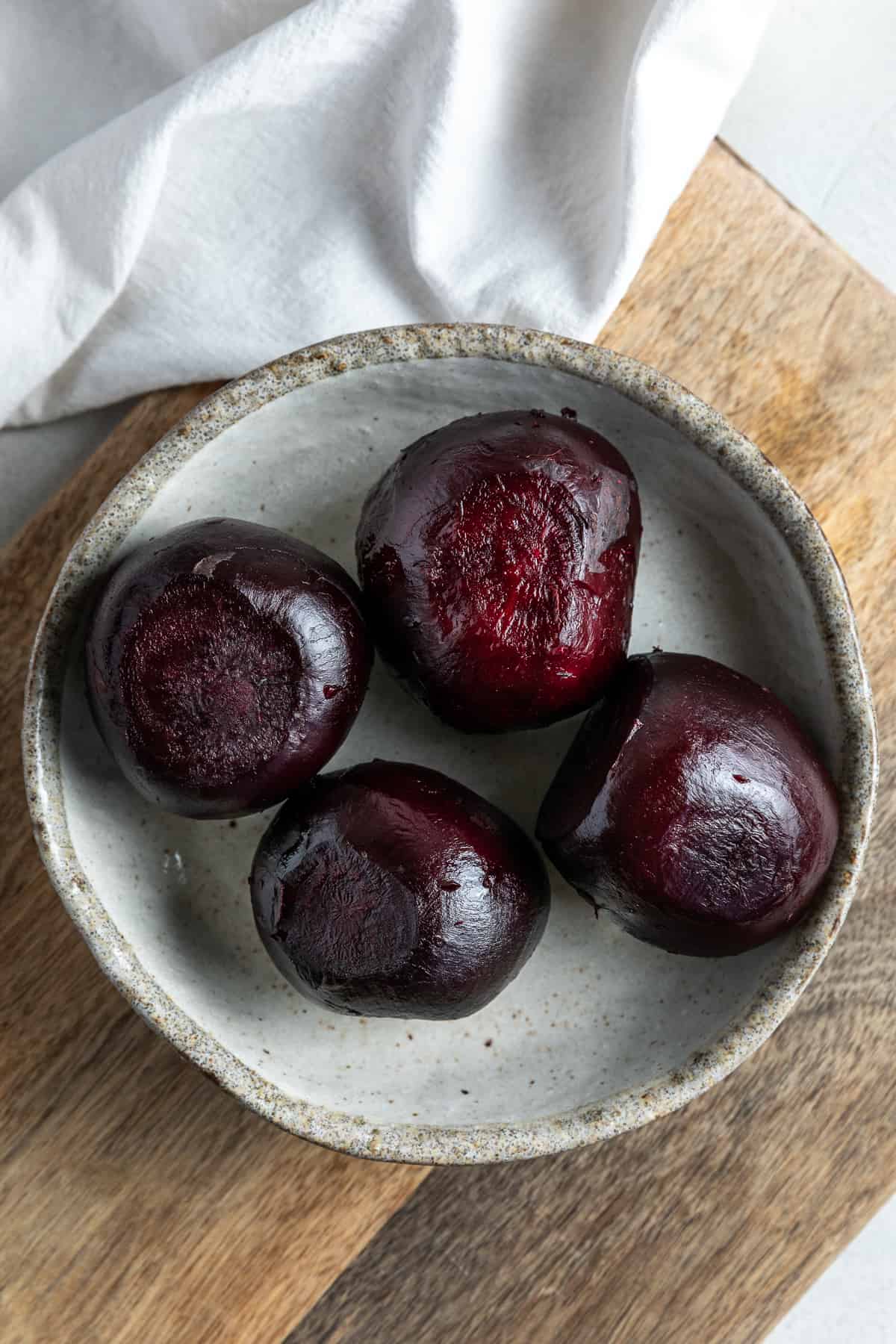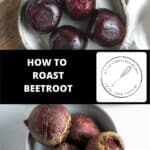In this post, we will share our simple technique for How to Roast Beetroot. It is a delicious way to prepare this beautiful root vegetable. Roasting the beetroot is a simple process that concentrates the natural sweetness, whilst the flesh becomes perfectly cooked and tender, yet still maintains some firmness. Use the roasted beetroot in salads, sandwiches, dips, baking and more!

Jump to:
Why we love this recipe:
Whilst there is more than one way to cook beetroot/beets, this is the method I prefer. It is quick and easy to boil them, but this tends to drain away a lot of colour, and consequently, flavour and nutrients. There are times when roasting them in pieces on a sheet pan appeals, but the beets may become dry and shrivelled.
You will love this method because:
- Sealing the beets in foil and then roasting them traps steam which in turn keeps the flesh moist and accentuates their natural sweetness.
- When they are cooked, their skins slip off easily.
- They lose less of their juice, maintaining colour, flavour and nutritients.
- There is minimal hands-on time involved, leaving you to attend to something else whilst they are roasting.
- You can use them in so many ways.
Ingredients in this recipe:

Bunch of beetroot/beets - when buying a bunch of beetroot, the leaves will most likely be attached. The leaves and stems are delicious roasted also! If you prefer, you can buy the beetroot individually and select the number that you require.
Step by step instructions:

To cook the beetroot, heat your oven to 200 degrees C (400 F).
If the beets still have their leaves, use a sharp knife and cut them off. Set them aside for another use. Wash the beetroots under cold running water. You don't need to dry them.
- Wrap them loosely in aluminium foil.
- Place in a large baking dish or on a rimmed baking tray to catch any juices which may leak.
- Roast in the preheated oven for 45-60 minutes, depending on size, until the beets are cooked. Set them aside until they are cool enough to handle. Trim the stem and root end.
- To avoid staining your fingers, you may like to wear disposable rubber gloves. Rub the skin away with a paper towel or peel it away with your fingers. It should peel away easily. If there are any tough pieces of skin, use a sharp paring knife to remove them. You are now ready to use the Roast Beetroot.

Tips for success and FAQs:
As beetroot stains so readily, I recommend that you wear disposable gloves. And be aware that the juice will stain any porous material, such as a wooden chopping board, kitchen bench or clothing. I recommend that you use a plastic chopping board.
Look for medium-size beetroot that are firm with unblemished skin and ideally a uniform size so they cook in a similar time. Firmness indicates that they are fresh. If the leaves are still attached, they are also a good indicator of freshness. They should be bright green and not wilted.
If the beetroots have the leaves still attached, you will need to separate them so the leaves last longer. Take a sharp knife and cut the leaves off, leaving about 2.5 cm (1 inch) of stems on the beetroot. Wrap the leaves loosely in paper towels and store them in the crisper drawer in a plastic bag. Depending on how fresh they were, they should last about 3 days. Store the beets in an airtight container or plastic bag in the crisper section of your fridge. They should last about 2 weeks. Do not wash them before refrigerating or they will spoil quicker.
Use them as you would silverbeet. With their ruby-coloured stems and green leaves, they are a colourful and nutritious side dish. They are delicious sauteed in a frying pan with some olive oil and garlic and cook up tender and sweet. For a delicious breakfast, add a poached or fried egg. Alternatively, you can add them to soups or stews.
My preference is to roast them in a foil packet. Roasting them in a well-sealed foil packet produces steam which keeps them moist and roasting enhances their natural sweetness. However, you can also boil them. Just add trimmed and washed beetroot to a pan of boiling salted water, bring to a boil, reduce heat and simmer 35-50 minutes depending on the size of the beetroot. Use a skewer to test when done. Boiling does remove a great deal of the colour and consequently some of the flavour.
It is easier to peel them after they are cooked as the skins just slip off. Just make sure to do it while they are still warm; once cold, it is more difficult. To avoid stained fingers, wear disposable gloves to peel and slice the beetroot. As well, they will stain any porous surfaces such as your clothing or a wooden chopping board.
When cool, store cooked, peeled beetroot in an airtight container in the fridge for up to 3 days. You can also freeze the cooked beetroot for up to 3 months in an airtight container. You may find the texture will be a little softer.

Serving suggestions:
There are so many ways to use Roasted Beetroot. They are a great addition to salads; one of my favourites is a Beetroot and Goat Cheese Salad. Sometimes I like them as a simple side dish, served warm, just with a squeeze of lemon juice and some sea salt flakes. Or, finely slice a bulb and add it to Crostini with feta and mint. Use them to make a colourful dip or include some in smoothies.
You will find many ways to enjoy this vibrantly coloured, nutritious root vegetable. I look forward to hearing if you make them, and how you like to serve them.
Alex xx

How to Roast Beetroot
Please note:
For accuracy, when weights are provided, we recommend weighing your ingredients. This will produce the best results. All oven temperatures listed are for fan forced.
Ingredients
- 1 bunch beetroot/beets See Note 1
Serving suggestion:
- seasonings: salt, pepper, olive oil, lemon juice - to taste
Instructions
- Heat your oven to 200 degrees C (400 F).
- If the beets still have their leaves, use a sharp knife and cut them off, leaving about 2.5 cm (1 inch) of stems on the beetroot. Don't cut off the roots or you will lose some of the beet juices and flavour. Don't discard the leaves, set them aside for another purpose, you can cook them as you would silverbeet. They cook up tender and sweet. See Note 2.Wash the beetroots under cold running water. You don't need to dry them.
- Wrap each of the beetroots individually loosely in aluminium foil, making sure they are completely covered. See Note 3.Place in a large baking dish or on a rimmed baking tray to catch any juices which may leak.
- Roast in the preheated oven for 45-60 minutes until the beets are cooked.
- To test if they are done, insert a skewer, through the foil, into the centre. They are done when a skewer slides easily through the beet flesh. Small beets will cook more quickly than large ones.
- Set them aside to cool in the foil until they are cool enough to handle. To avoid staining your fingers, you may like to wear disposable rubber gloves. As well, I recommend a plastic chopping board as the beetroot will stain any porous material, such as your chopping board or your clothing.
- With a sharp knife, trim the stem and root end. Rub the skin away with a paper towel or peel it away with your fingers. It should peel away easily. Do this while they are still warm as it will be more difficult when they are cold.If there are any tough pieces of skin, use a sharp paring knife to remove them.
- Your beets are now ready. There are so many ways to use Roasted Beetroot. They are a great addition to salads. Sometimes I like them as a simple side dish, served warm, just with a squeeze of lemon juice and some sea salt flakes. Or, finely slice a bulb and add it to Crostini with feta and mint. Use them to make a colourful dip or include in smoothies.
- When cool, store cooked, peeled beetroot in an airtight container in the fridge for up to 3 days. You can also freeze the cooked beetroot for up to 3 months in an airtight container. You may find the texture will be a little softer.
Notes
- I like to buy a bunch of beetroot as I can use the leaves separately. However, they are often different sizes and you may prefer to buy loose beetroot of a similar size.
- To keep the leaves fresh for a few days, wrap them loosely in some damp paper towel, place them in a plastic bag and store them in the crisper drawer of your fridge. Use the leaves as you would silverbeet. With their ruby-coloured stems and green leaves, they are a colourful and nutritious side dish. They are delicious sauteed in a frying pan with some olive oil and garlic and cook up tender and sweet. For a delicious breakfast, add a poached or fried egg.
- If you prefer, you may like to wrap them first in some baking paper to keep them separate from the foil.
Nutrition Estimate:
Nutritional Disclaimer:
The nutritional information is an estimate only, and is derived from online calculators. For accurate results, we recommend calculating the nutritional information based on the ingredients and brands you use.















Timothy Holmes says
Thank you so much. I am getting busy right now.
Alexandra Cook says
Enjoy the beetroot, Timothy 🙂
jim says
I find a carving fork to hold them is just as easy and no disposable gloves. I peel them with a flat knife just sliding it down the sides once the top and bottom have been removed. Usually use a red plastic board .
Alexandra Cook says
Thanks for sharing, Jim 🙂
What's your favourite way of using the beetroot?
Francois says
Must I wrap them in foil. Why can I not just rub olive oil on them and roast open in a baking Tray?
Alexandra Cook says
Hi Francois,
We use this method as we don't want the beetroot to go too dry on the outside, and prefer them to be remain tender and juicy. The foil protects them, and allows some steam to be trapped, and also makes the skins easier to peel.
You can certainly roast them open in a baking tray if you prefer (there are many other posts that detail this method) - or even wrap them in parchment paper before the foil if you don't want the foil coming in direct contact with the beets.
Hope that helps! Thanks, Alex
Keri says
I always used to peel beetroot before cooking it, and this was just the info I needed. It's much simpler to roast them with their skins on, and remove the peel afterwards. Thanks for the great tip!
Alexandra says
Hi Keri, thank you for your fantastic feedback. I'm glad you found the tip helpful. 🙂